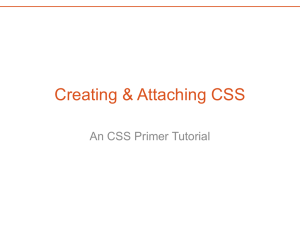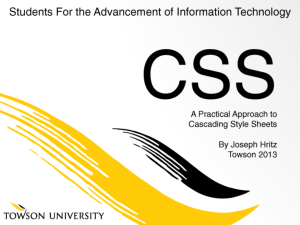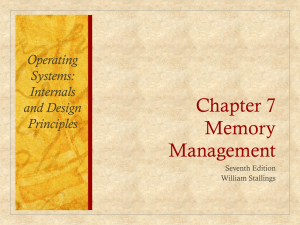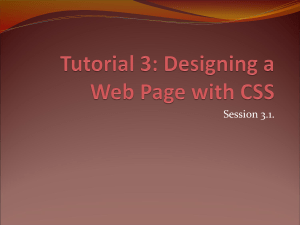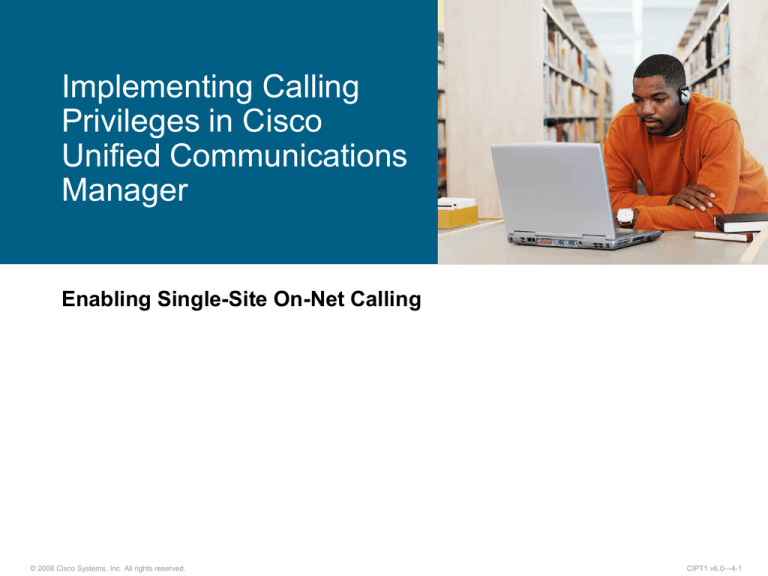
Implementing Calling
Privileges in Cisco
Unified Communications
Manager
Enabling Single-Site On-Net Calling
© 2008 Cisco Systems, Inc. All rights reserved.
CIPT1 v6.0—4-1
Outline
Calling Privileges Overview
Partitions and Calling Search Spaces
Time Schedules and Time Periods
Client Matter Codes and Forced Authorization Codes
Calling Privileges Applications Overview
Implementing Class of Service
Implementing 911 and Vanity Numbers
Implementing Time of Day-Based Carrier Selection
Implementing Private Line, Automatic Ringdown
© 2008 Cisco Systems, Inc. All rights reserved.
CIPT1 v6.0—4-2
Calling Privileges Overview
© 2008 Cisco Systems, Inc. All rights reserved.
CIPT1 v6.0—4-3
Calling Privileges
Calling privileges (also called class of service) define the
entries of a call routing table that can be accessed by an
endpoint performing a call routing request.
Used to control telephony charges
– Block costly service numbers
– Restrict international calls
Used for special applications including:
– Route calls with the same number differently per user
(different gateway per site for PSTN calls)
– Route calls to the same number differently per time of day
© 2008 Cisco Systems, Inc. All rights reserved.
CIPT1 v6.0—4-4
Call Privileges Requirement Example
Calling Privilege Class
Allowed Destinations
(Class of Service)
Internal
Local
Internal
Emergency
Internal
Emergency
Local PSTN
Internal
Long Distance
Emergency
Local PSTN
Long Distance PSTN
Internal
Emergency
International
Local PSTN
Long Distance PSTN
International PSTN
© 2008 Cisco Systems, Inc. All rights reserved.
CIPT1 v6.0—4-5
Call Privileges Configuration Elements
Call Privileges Element
Partitions
Calling Search Spaces
(CSSs)
Time Schedules and
Time Periods
Client Matter Codes
(CMC)
Forced Authorization
Codes (FAC)
© 2008 Cisco Systems, Inc. All rights reserved.
Characteristics
Group of numbers (directory numbers, route patterns,
translation patterns, etc.) with similar reachability
characteristics
Defines which partitions are accessible to a particular
device
Used to allow certain partitions to be reachable only during
a certain time of the day
Used to track calls to certain numbers
A user must enter a Client Matter Code to track calls to
certain clients
Restrict outgoing calls to certain numbers
A user must enter an authorization code to reach the
number
CIPT1 v6.0—4-6
Partitions and Calling Search Spaces
© 2008 Cisco Systems, Inc. All rights reserved.
CIPT1 v6.0—4-7
Partitions and Calling Search Spaces
A partition is a group of numbers with same reachability.
– Any dialable patterns can be part of a partition (directory
numbers, route patterns, translation patterns, voice-mail ports,
Meet-Me conference numbers, etc.).
Calling search space is a list of partitions and includes the
partitions that are accessible by this CSS.
– A device can call only those numbers located in the partitions
that are part of its calling search space.
– Assigned to any entity that can generate a call routing request,
including phones, phone lines, gateways, and applications.
© 2008 Cisco Systems, Inc. All rights reserved.
CIPT1 v6.0—4-8
Partition <None> and CSS <None>
Before partitions and CSS are configured, all entities that can
have a partition (i.e., called entities such as directory numbers,
route patterns, etc.) reside in partition <None>, and all entities that
can have a CSS (calling entities such as phones or trunks) are
assigned with CSS <None>.
Entities that are in partition <None> are always accessible
(regardless whether the calling entity has a CSS or not).
Entities that have CSS <None> assigned can only access entities
that are in partition <None>.
© 2008 Cisco Systems, Inc. All rights reserved.
CIPT1 v6.0—4-9
Analogy: Locks and Key Rings
No
Partition
Assigned
Partitions:
Phones
Phone1
Phone2
Phone3
Phone4
No CSS
Assigned
CSSs:
Effective
Permissions:
© 2008 Cisco Systems, Inc. All rights reserved.
Phone5
Phone1: Phone2, Phone3, Phone4, Phone5
Phone2: Phone1, Phone3, Phone4, Phone5
Phone3: Phone2, Phone4
Phone4: Phone1, (Phone4)
Phone5: Phone4
CIPT1 v6.0—4-10
Basic Partitions and CSS Example
Phone CSS
contains two
partitions.
1
2
CSS
User dials 3001.
Partition Chicago
3001
Phone 2-1 DN 3001
lies in partition
Chicago.
Phone 2-1
3
Phone 2-1 will ring.
Partition San Jose
2001
Phone 1-1
Partition Atlanta
4001
© 2008 Cisco Systems, Inc. All rights reserved.
Phone 3-1
Phone 3-1 DN 4001
lies in partition
Atlanta.
Not included in
routing decision.
CIPT1 v6.0—4-11
CSS Partition Order Relevance
A CSS is an ordered list of partitions.
All accessible entities of the call routing table are considered by
best-match logic.
– Entities which are in a partition that is listed in the CSS of the
calling entity
– Entities which do not have a partition assigned
Multiple identical entities can exist in the call routing table but
must be in different partitions.
If no single best match, the entry of the call rouitng table is used
whose partition is listed first in the CSS of the calling device.
Resulting route selection priorities:
1.Best match
2.If multiple, equally qualified matches, order of partition is tie
breaker
© 2008 Cisco Systems, Inc. All rights reserved.
CIPT1 v6.0—4-12
Partitions and CSS Example with
Multiple Best Matches
Phone CSS
contains two
partitions.
1
CSS
User dials 3001.
Partition Chicago
3001
2
Phone 2-1 and
Phone
Phone2-1
1-1 match
and
equally
Phone1-1
well.match
Phone
equally
2-1 is used
well.because
Phone21its
is partition
used because
is listed
its
first
partition
in calling
is listed
phone’s
first.
CSS.
© 2008 Cisco Systems, Inc. All rights reserved.
Phone 2-1
Partition San Jose
3001
Phone 1-1
Partition Atlanta
3001
Phone 3-1
Phone 2-1 DN 3001
lies in partition
Chicago.
Phone 1-1 DN 3001
lies in partition San
Jose.
Phone 3-1 DN 3001
lies in partition
Atlanta.
Not included in
routing decision.
CIPT1 v6.0—4-13
Phones Have a Device CSS and
Line CSS
IP phones can have a
CSS configured at each
line and at the device.
CSS of the line from
which the call is placed is
considered first
Line CSS
Partition L1
Resulting CSS
Partition L3
Partition L1
Line
Partition L2
Partition L3
Device CSS is then
added
Partition D1
Effective CSS consists of:
1. Line CSS
Partition L2
Device CSS
Partition D2
Partition D1
Partition D3
Partition D2
Device
Partition D3
2. Device CSS
© 2008 Cisco Systems, Inc. All rights reserved.
CIPT1 v6.0—4-14
Example with IP Phone Line CSS and
Device CSS
A phone with both line and
device CSS configured dials
extension “3001”.
Line CSS and device CSS are
concatenated with line CSS on
top of device CSS.
Route pattern 300X is eliminated
because other entries are better
matches.
Two entries in different partitions
(Chicago and Atlanta) found by
best-match algorithm.
Best match of first listed partition
(Chicago) is used.
© 2008 Cisco Systems, Inc. All rights reserved.
Line CSS
Partition San Jose
300X
Route Pattern
Partition Chicago
3001
Phone 2-1
Device CSS
Partition Atlanta
3001
Phone 3-1
CIPT1 v6.0—4-15
Class of Service Sample Scenario
Assigned CSS determines
calling privilege
CSS Internal
CSS Local
CSS LD
CSS International
Partition Phones
Internal Calls
Local Calls
Long-Distance
Calls
International
Calls
© 2008 Cisco Systems, Inc. All rights reserved.
(all Phone DNs)
X
X
X
Partition Local-PSTN
9[2-9]XXXXXX
X
X
Partition LD-PSTN
91[2-9]XX[2-9]XXXXXX
X
Partition
Intl-PSTN
9011!#
CIPT1 v6.0—4-16
Configuring Partitions and Calling
Search Spaces
There are two steps of configuration:
Partition configuration in Cisco Unified CM:
1. Create new partitions.
2. Assign partitions to directory numbers, route patterns,
translation patterns.
Calling search spaces configuration in Cisco Unified CM:
1. Create new calling search space.
2. Select list of partitions for each calling search space.
3. Assign calling search space to lines, devices, and translation
patterns.
© 2008 Cisco Systems, Inc. All rights reserved.
CIPT1 v6.0—4-17
Creating Partitions
Enter list of
partitions and
descriptions
(separated by
comma)
© 2008 Cisco Systems, Inc. All rights reserved.
CIPT1 v6.0—4-18
Assigning Partitions
Note: Assign partitions to directory numbers, route patterns,
translation patterns, etc.
© 2008 Cisco Systems, Inc. All rights reserved.
CIPT1 v6.0—4-19
Creating a Calling Search Space
Add or remove
highlighted partition
to or from CSS
Change order of partitions in CSS by
moving highlighted partition up or down
© 2008 Cisco Systems, Inc. All rights reserved.
CIPT1 v6.0—4-20
Assigning CSS to IP Phone
Assign CSS to
Phone
Note: Assign
CSSs to
devices
(phones/lines),
gateways,
translation
patterns, etc.
© 2008 Cisco Systems, Inc. All rights reserved.
CIPT1 v6.0—4-21
Time Schedules and Time Periods
© 2008 Cisco Systems, Inc. All rights reserved.
CIPT1 v6.0—4-22
Time-of-Day Routing Overview
Time and date information can be applied to partitions.
CSSs that include such a partition only have access to the
partition if the current date and time match the time and date
information applied to the partition.
Allows different routing based on time
– Identical route pattern is put into multiple partitions.
– At least one partition has time information applied.
– If this partition is listed first in CSSs, it will take precedence
over other partition during the time applied to the partition.
– If time does not match, second partition of CSS is used
(first one is ignored due to invalid time).
© 2008 Cisco Systems, Inc. All rights reserved.
CIPT1 v6.0—4-23
Time-of-Day Routing Applications
Allow international calls only during office hours (based on the
time zone of the caller)
Block international calls on holidays
Other applications in which you want to control the calling search
space based on the time of day:
– Least cost routing:
Multiple providers for international calls
Different prices per hours of the day
Time-of-day routing allows dialing different providers for
same destination (country) based on time
© 2008 Cisco Systems, Inc. All rights reserved.
CIPT1 v6.0—4-24
Time Periods and Time Schedules
Time period
Time range defined by start
and end time
Repetition interval—Days of
the week or specified
calendar date
Associated with time
schedules
Time Periods
Start–End
weekdayhrs_TP
weekendhrs_TP
newyears_TP
noofficehours_TP
0800–1700
0800–1700
0000–2400
Time Schedule
RegEmployees_TS
Repetition
M–F
Sat – Sun
January 1
Sat – Sun
Time Periods
weekdayhrs_TP
Time schedule
Group of time periods
Assigned to partitions
Determines the partitions
that calling devices search
when they are attempting to
complete a call during a
particular time of day
© 2008 Cisco Systems, Inc. All rights reserved.
Partition
CiscoAustin_PT
Time Schedule
RegEmployees_TS
CIPT1 v6.0—4-25
Example: Block International Calls
During Weekends and on January 1
1
Dials 9.0114369918900009
Current Time: 10:00
Current Day: Wed
CSS:
Weekend
2
Standard
Dials
9.0114369918900009
Current Time: 20:00
Current Day: Sat
First Partition (Weekend) is
ignored because no time
match. Pattern not blocked.
First Partition (Weekend) is
active, matched, and listed first.
Pattern blocked.
Route Pattern: 9.011!
Partition: Weekend
Block This Pattern!
Route Pattern: 9.011!
Partition: Standard
Route to PSTN
Partition Standard: (no time schedule)
© 2008 Cisco Systems, Inc. All rights reserved.
Partition Weekend: Time Schedule: TS1
Time Schedule TS1: Time Period: TP1, TP2
TP1: 00:00–24:00 Sat-Sun
TP2: 00:00–24:00 Jan 1
CIPT1 v6.0—4-26
Time-of-Day Routing Configuration
Procedure
1. Create time periods.
2. Create time schedules.
3. Assign time schedules to partitions.
© 2008 Cisco Systems, Inc. All rights reserved.
CIPT1 v6.0—4-27
Creating Time Periods
TP1 is active
Saturday and
Sunday from 00:00
to 24:00
TP2
TP2 is
is active
active
Jan
Jan 1 from
from
0:00 to
00:00
to 24:00
24:00
© 2008 Cisco Systems, Inc. All rights reserved.
CIPT1 v6.0—4-28
Creating Time Schedules
Add or remove
highlighted time
period to or from
time schedule
© 2008 Cisco Systems, Inc. All rights reserved.
CIPT1 v6.0—4-29
Assigning Time Schedules to Partition
Assign time
schedule to
partition
Set fixed time zone
or use time zone of
call originating
device
Partition is only active in CSS if call is placed during time specified
in time schedule.
© 2008 Cisco Systems, Inc. All rights reserved.
CIPT1 v6.0—4-30
Client Matter Codes and Forced
Authorization Codes
© 2008 Cisco Systems, Inc. All rights reserved.
CIPT1 v6.0—4-31
Client Matter Codes and
Forced Authorization Codes
CMC: Forces the user to enter any
configured CMC
– Allows for billing and tracking of calls
made per client
FAC: Forces the user to enter a
configured authorization code with a
high-enough authorization level
– Prevents unauthorized user from
making toll calls
– Can be combined with time-of-day
routing (e.g., international calls outside
business hours require FAC)
Both generate Call Detail Records
© 2008 Cisco Systems, Inc. All rights reserved.
CIPT1 v6.0—4-32
CMC Call: Successful Call
1. Dial number that goes to
CMC-enabled route pattern
2. Unified CM tells phone to play
tone to prompt for CMC
CMC:
1234
1244
3489
User A
© 2008 Cisco Systems, Inc. All rights reserved.
3. User enters valid code number
4. Call extended
5. Generate CDR for billing
Voice GW
CIPT1 v6.0—4-33
CMC Call: Call Failure
1.
2.
CMC:
3.
1234
1244
3489
4.
5.
User A
© 2008 Cisco Systems, Inc. All rights reserved.
Dial number that goes to a
CMC-enabled route pattern
Unified CM tells phone to play
tone to prompt for CMC
User enters invalid CMC
number
User receives reorder tone
Generate CDR to log attempt
Voice GW
CIPT1 v6.0—4-34
FAC Call: Successful Call
1. Dial number that goes to an
FAC-enabled route pattern
2. Unified CM tells phone to play
tone
3. User enters authorization code
FAC:
1234: Level 1
1244: Level 2
1888: Level 7
4. Code is known and authorization
level is not lower than required
level configured at route pattern
5. Call extended
6. Generate CDR
User A
© 2008 Cisco Systems, Inc. All rights reserved.
Voice
CIPT1 v6.0—4-35
FAC Call: Call Failure
1. Dial number that goes to an
FAC-enabled route pattern
2. Unified CM tells phone to play
tone
3. User enters authorization code
FAC:
1234: Level 1
1244: Level 2
1888: Level 7
4. Code is not known or its
authorization level is lower than
the one configured at the route
pattern
5. User receives reorder tone
6. Generate CDR to log attempt
User A
© 2008 Cisco Systems, Inc. All rights reserved.
Voice
CIPT1 v6.0—4-36
Calling Privileges Applications Overview
© 2008 Cisco Systems, Inc. All rights reserved.
CIPT1 v6.0—4-37
Different Ways Of Using Calling
Privileges Configuration Tools
Partitions and CSS are primarily used to implement class of
service.
Primariliy used to implement class of service when you must to permit or
deny access to a certain number
– International versus long distance versus local
– Direct access to managers versus going through assistant
– Can include time of day or require an authorization code
Configuration tools can also be used for applications such as these.
– Vanity numbers: depending on who is calling a number, the call is
routed differently
– Time of day-based path selection: depending on time a number is
called, call is routed differently
– Private line, automatic ringdown (PLAR): automatically dial one
specific number when phone goes off-hook
© 2008 Cisco Systems, Inc. All rights reserved.
CIPT1 v6.0—4-38
Calling Privileges Application Examples
Applications
Class of service: Limiting
access to certain destinations
911 emergency calls and
vanity numbers
Time of day-based carrier
selection
Mandatory call accounting
PLAR
© 2008 Cisco Systems, Inc. All rights reserved.
Description
Traditional calling privileges; who is allowed to call
where or whom.
All users dial the same number, but depending on the
caller, the call goes to a different destination.
Time-of-day routing is used to select different carriers
based on the time of the day.
Calls must be flagged: Business versus private calls,
client-based call accounting and billing, etc.
Going off-hook connects the phone to a specific
destination; user cannot dial.
CIPT1 v6.0—4-39
Implementing Class of Service
© 2008 Cisco Systems, Inc. All rights reserved.
CIPT1 v6.0—4-40
Class of Service
Collection
ofClass
calling
permissions assigned to individual
Class of
of
Service 1
Service 2
users.
Lobby
Employee
Executive
Emergency
Local
Long Distance
PSTN
International
Employee
© 2008 Cisco Systems, Inc. All rights reserved.
CIPT1 v6.0—4-41
Implementing CoS: Traditional Approach
Place external route patterns in partitions associated with the
destinations that they can call
Configure each calling search space to be able to reach only the
partitions associated with its call restriction policy
Assign these calling search spaces to the phones by configuring
them on the Unified CM device pages (all lines on the device
automatically receive the same CoS)
© 2008 Cisco Systems, Inc. All rights reserved.
CIPT1 v6.0—4-42
Traditional Approach – Example:
Single Site
Calling
Search
Space
assigned
to device
based on
class of
service
Calling Search
Spaces
Partitions
Route
Lists
Route
Groups
Devices
Internal_pt
Internal_css
All IP Phones
911
Route
Patterns
9.911
Local_css
Local_pt
9.[2-9]XXXXXX
LD_css
LD_pt
PSTN
RL
PSTN
RG
PSTN
9.1[2-9]XX
[2-9]XX XXX
Intl.pt
9.011!
Intl_css
© 2008 Cisco Systems, Inc. All rights reserved.
9.011#
CIPT1 v6.0—4-43
Traditional Approach – Example:
Multiple Sites
Calling Search Spaces
Device Calling Search
Spaces (4 for site 1)
Site1Internal
Partitions
On Cluster
IP Phones
Shared
VM ports, MeetMe…
Site1Local
Site1Emergency
9.11
Site1National
Site1International
9.911
Site Local
9.1[2-9]XXXXXX
Local_pt
Device Calling Search
Spaces (4 for site N)
Site1National
9.1 [2-9]XX
[2-9]XX XXXX
Local_pt
SiteNInternal
Site1International
9.011!
9.011!#
SiteNLocal
SiteNEmergency
9.11
9.911
SiteNNational
SiteNInternational
SiteNLocal
9.[2-9]XXXXXX
Local_pt
1RL
1RG
Site 1
Gateways
NRL
NRG
SiteNNational
9.1 [2-9]XX
[2-9]XX XXXX
Local_pt
SiteNInternational
9.011!
9.011!#
© 2008 Cisco Systems, Inc. All rights reserved.
Route Lists/Route Groups
Site N
Gateways
CIPT1 v6.0—4-44
Line Device Approach: Improves
Scalability
Significantly decreases the total number of partitions and
CSS required.
Use the device calling search space to provide call routing
information (for example, which gateway to select for all PSTN
calls).
Use the line calling search space to provide class of service
information (for example, which of the PSTN calls to block).
© 2008 Cisco Systems, Inc. All rights reserved.
CIPT1 v6.0—4-45
Line Device Approach – Concept
Line CSS
selectively blocks
undesired routes
(according to
class of service)
Line CSS
Block Int’l Partition
9.011!
Line
Device CSS
Device CSS
allows access to
all external routes
Device
PSTN Partition
9.[2-9]XXXXXX
9.1 [2-9]XX [2-9]XX XXXX
9.011!
“Blocked”
Route/Translation Patterns
Resulting CSS
Block Int’l Partition
9.011!
PSTN Partition
9.[2-9]XXXXXX
9.1 [2-9]XX [2-9]XX XXXX
9.011!
“Routed” Route Patterns
Device CSS contains only one partition with route patterns to all PSTN
numbers using a specific PSTN gateway.
For each PSTN gateway, route patterns exist once in a different partition.
Line CSS contains a partition with a single route pattern that matches
international numbers and has been configured as a blocked pattern.
Regardless of the used gateway, this same partition can be used to block
international calls.
© 2008 Cisco Systems, Inc. All rights reserved.
CIPT1 v6.0—4-46
Line Device Approach – Example:
Multiple Sites
Calling Search
Spaces
Partitions
Route
Lists
Route
Groups
Internal
Device CSS (1 for site N)
Line CSS (4 Global)
Device CSS (1 for site 1)
OnCluster
IP Phones
Shared
VM Ports, MeetMe…
Site1Devices
PSTN Partition
9.11
Local
National
BlockLocalPSTN
9.[2-9]XXXXXX
BlockNationalPSTN
9.1 [2-9]XX [2-9]XX XXXX
BlockIntlPSTN
9.011!
9.011!#
9.911
9.[2-9]XXXXXX
9.1 [2-9]XX [2-9]XX XXXX
1 RL
1 RG
International
NoBlock
9.911!
Empty
9.011!#
Site 1
Gateways
SiteNPSTN
9.11
SiteNDevices
9.911
9.[2-9]XXXXXX
9.1 [2-9]XX [2-9]XX XXXX
N RL
N RG
9.911!
9.011!#
Site N
Gateways
© 2008 Cisco Systems, Inc. All rights reserved.
CIPT1 v6.0—4-47
Implementing 911 and Vanity Numbers
© 2008 Cisco Systems, Inc. All rights reserved.
CIPT1 v6.0—4-48
911 Emergency Number
911 is a single number to call for medical, fire, and police
emergencies, legislated in Canada and United States:
Calls to 911 are routed to a PSAP. The PSAP is the first-tier triage
call center for emergency calls.
911 calls must always be sent to the local PSAP .
Calls to the same number must be routed differently per phone
(location).
© 2008 Cisco Systems, Inc. All rights reserved.
CIPT1 v6.0—4-49
Vanity Numbers
Vanity numbers provide a certain local service
Same number regardless of your physical location
Examples:
– Dial 7999 at any site to get local IT support (on-net)
– Dial 7998 at any site to get local travel agency (off-net)
Number can be a route pattern, directory number, or hunt pilot
911 emergency dialing has the same basic concept
– Dial 911 at any site to get to local emergency services (off-net,
emergency call)
© 2008 Cisco Systems, Inc. All rights reserved.
CIPT1 v6.0—4-50
Implementing Emergency and Vanity
Numbers in Unified CM
Create a site-specific partition for each physical location.
For each service, configure the same vanity number (route pattern
or directory number or hunt pilot) once per physical location and
apply respective site-specific partition.
Put the appropriate site-specific partition into the CSS of phones.
© 2008 Cisco Systems, Inc. All rights reserved.
CIPT1 v6.0—4-51
Vanity Number Example
CSS:
San Jose
DN: 7999
Standard
Partition:
San Jose Phone
San Jose
IT Helpdesk
San Jose
Both users dial 7999 for local IT helpdesk.
San Jose user is connected to San Jose helpdesk phone.
New York user is connected to New York helpdesk phone.
CSS:
DN: 7999
New York
Partition:
Standard
New York
New York Phone
© 2008 Cisco Systems, Inc. All rights reserved.
IT Helpdesk
New York
CIPT1 v6.0—4-52
Implementing Time of Day-Based
Carrier Selection
© 2008 Cisco Systems, Inc. All rights reserved.
CIPT1 v6.0—4-53
Implementing Time of Day-Based Carrier
Selection
Different approaches depending on scenario:
Dedicated gateway per carrier
– Configure required route patterns (international, long distance, local,
etc.) once per carrier pointing to appropriate carrier gateway; put
route patterns into a carrier-specific partition
– Apply time-of-day settings to each partition and include all partitions in
CSS of phones
Single PSTN access with carrier access code (1010) and 3-digit carrier
identification code
– Configure route patterns; once per carrier and transform dialed
number to include carrier access and carrier identification codes; put
them into a carrier-specific partition
– Apply time-of-day settings to each partition and include all partitions in
CSS of phones
© 2008 Cisco Systems, Inc. All rights reserved.
CIPT1 v6.0—4-54
Time of Day-Based Carrier Selection
Example
Route pattern:
9011.!
CSS:
C111
Standard
User dials 9-01143-699-18900009
Partition: C111
(time schedule for
business hours)
DDI: PreDot
Prefix:
1010111011
Route pattern:
9.011!
Partition: Standard
(no time schedule)
DDI: PreDot
© 2008 Cisco Systems, Inc. All rights reserved.
If call is placed during
business hours, partition
C111 (currently active
and listed first in CSS) is
used:
9-011-43-699-18900009
is changed to 1010-111011-43-699-18900009
If call is placed outside
business hours, partition
C111 is currently not
active and Standard
partition is used:
9-011-43-699-18900009
is changed to 011-43699-18900009
CIPT1 v6.0—4-55
Implementing Private Line, Automatic
Ringdown (PLAR)
© 2008 Cisco Systems, Inc. All rights reserved.
CIPT1 v6.0—4-56
Implementing PLAR
Use PLAR to make a phone dial a predefined number when
the phone goes off-hook.
Implemented by using partitions, CSS, and translation patterns
– Translation pattern with a null-string pattern is created and put into a
partition
– Dialed number (null-string) is transformed to PLAR destination
number
– Partition is the only entry in CSS of phone
– Translation pattern requires access to PLAR destination (CSS with
partition of PLAR destination or no partition at PLAR destination)
When phone goes off-hook, the dialed string (null string to indicate offhook status) matches the translation pattern and is translated to PLAR
number
© 2008 Cisco Systems, Inc. All rights reserved.
CIPT1 v6.0—4-57
PLAR Example
CSS:
PLAR1234
User goes
off-hook
Translation
pattern: “” (null
string)
Phone1 has only access
to translation pattern
with null string pattern.
Partition:
PLAR1234
When Phone1 goes offhook, the pattern is
matched.
Called Party
Transformation
Mask: 1234
Phone1
CSS: Phones
DN: 1234
DN: 1234
Partition: Hidden
Partition: Phones
Pattern is translated to
1234.
Translation pattern uses
CSS Phones and has
only access to Phone2 –
not to Phone3.
Call is set up to Phone2.
Phone3
© 2008 Cisco Systems, Inc. All rights reserved.
Phone2
CIPT1 v6.0—4-58
Summary
Calling privileges are implemented to implement class of service or
special applications that require calls to be treated differently
depending on the caller.
Partitions are groups of called numbers with identical reachability
characteristics. CSS are lists of partitions, that the owner of the CSS
has access to.
Time Schedules and Time Periods are used to activate or deactivate
partitions within a CSS depending on time and or date information.
Client Matter Codes are used to track calls to certain clients by
requesting the CMC to be entered and adding it into CDR. FAC are
used to allow access to route patterns only if an authorization code
with a high-enough level is entered when requested.
© 2008 Cisco Systems, Inc. All rights reserved.
CIPT1 v6.0—4-59
Summary (Cont.)
Calling privileges applications include implementation of class of
service, vanity numbers, time-based route or carrier selection, and
PLAR.
Complexity of CoS implementation at IP phones can be reduced by
using the line device approach, which allows the effective CSS to be
composed of a line and device CSS (in this order).
Vanity numbers provide access to local services by dialing the same
number from any physical location.
Time schedules and time periods can be used to route calls via
different gateways or carriers, depending on the time of the day or
date in order to take advantage of the cheapest rate at any time.
PLAR, a function in which a phone is automatically connected to a
predefined number when it goes off-hook, is implemented by using
null string translation patterns, partitions, and CSS.
© 2008 Cisco Systems, Inc. All rights reserved.
CIPT1 v6.0—4-60
© 2008 Cisco Systems, Inc. All rights reserved.
CIPT1 v6.0—4-61



